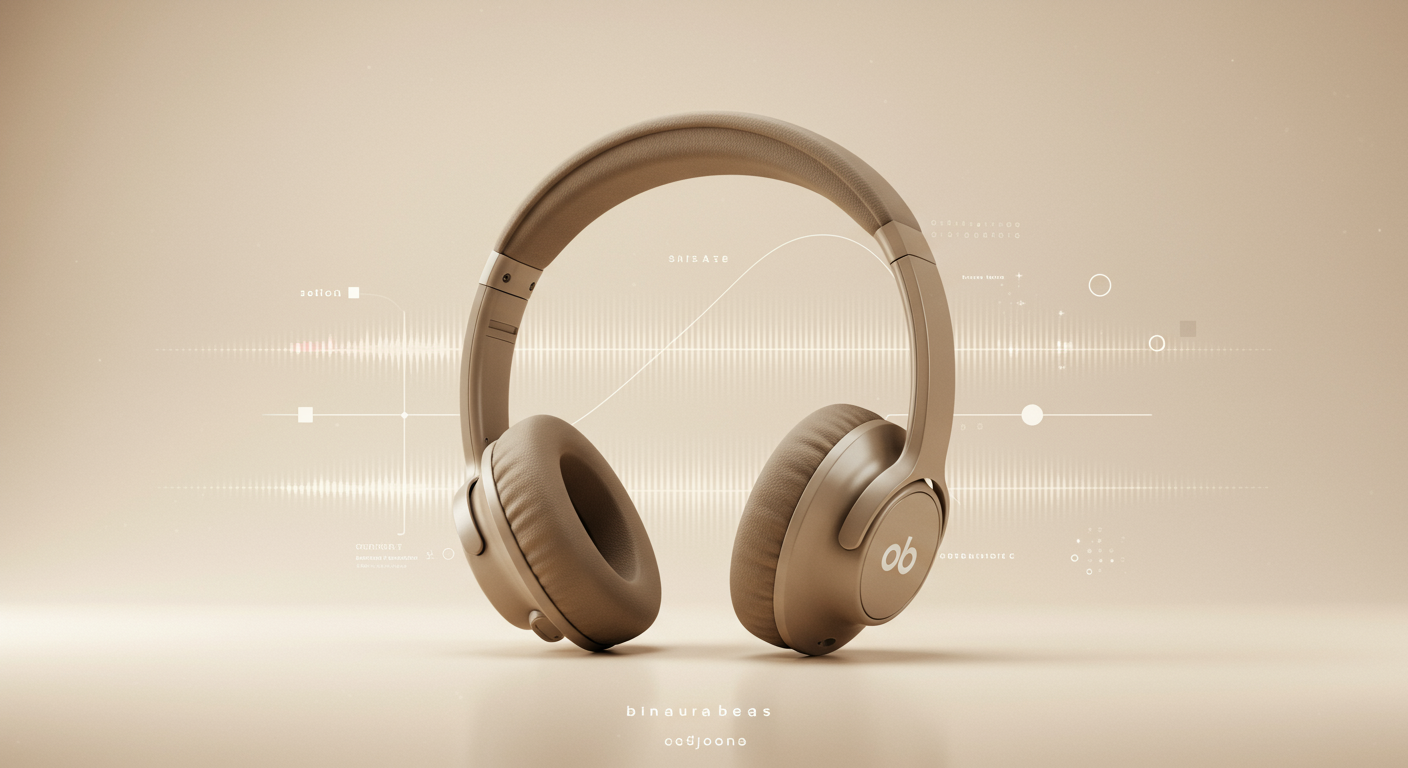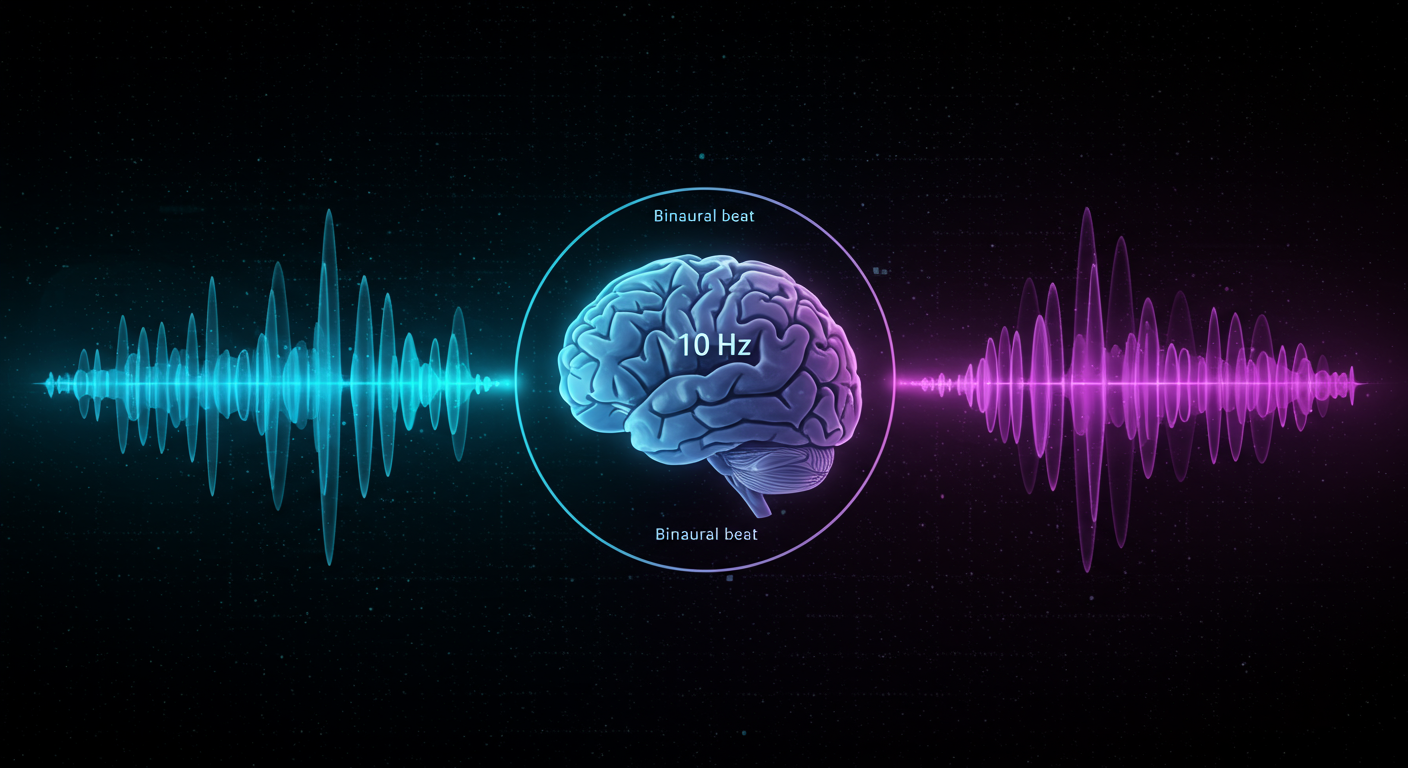What Are Binaural Beats? The Ultimate Guide to Focus, Sleep, and Relaxation

Discover the science behind binaural beats.
Our complete guide explains how they work, the different frequencies for sleep, focus, and anxiety, and how to use them safely.
Ever feel like your brain has too many tabs open? In a world of constant distraction, finding a state of deep focus, peaceful relaxation, or restful sleep can feel like a superpower. Enter binaural beats, a fascinating form of sound wave therapy that promises to help you tune your brain for optimal performance and well-being.
But what exactly are they, and is there any science to back up the claims?
This ultimate guide will answer all your questions. We'll explore the science behind how binaural beats work, their potential benefits, the different frequencies, and how you can start using them safely and effectively today.
Table of Contents
- What Are Binaural Beats? A Simple Explanation
- How Do Binaural Beats Work? The Science of Brainwave Entrainment
- The Different Frequencies: A Brainwave Cheat Sheet
- The Proven (and Potential) Benefits of Binaural Beats
- How to Use Binaural Beats Effectively: A Step-by-Step Guide
- Are Binaural Beats Safe? Precautions and Considerations
- Binaural Beats vs. Isochronic Tones vs. Monaural Beats
- Frequently Asked Questions (FAQ)
- Conclusion: Tune Into Your Potential
1. What Are Binaural Beats? A Simple Explanation
A binaural beat isn't a sound that actually exists in the outside world. It’s an auditory illusion created inside your brain.
Here’s how it happens:
You listen to two slightly different sound frequencies, one in each ear, using stereo headphones. For example, your left ear might hear a 300 Hz tone, while your right ear hears a 310 Hz tone.
Your brain, trying to make sense of these two different inputs, perceives a third, phantom beat. The frequency of this third beat is the mathematical difference between the two tones—in this case, 10 Hz (310 - 300 = 10).
This 10 Hz beat is the binaural beat. You don't "hear" it in the traditional sense; your brain generates it.

2. How Do Binaural Beats Work? The Science of Brainwave Entrainment
The theory behind why binaural beats are effective is a process called brainwave entrainment or "frequency-following response."
Your brain is constantly producing electrical impulses called brainwaves. These waves have different frequencies, which are measured in Hertz (Hz). Each frequency range is associated with a different mental state. For example, slow brainwaves are linked to sleep, while faster ones are linked to high alert and focus.
The principle of brainwave entrainment suggests that your brain will naturally start to synchronize its own brainwaves to match the frequency of the binaural beat you're listening to.
So, if you listen to a 10 Hz binaural beat, your brain may begin to produce more 10 Hz Alpha waves, which are associated with a state of calm relaxation. If you listen to a 4 Hz beat, your brain may be "entrained" toward the 4 Hz Theta waves associated with deep meditation and the early stages of sleep.
3. The Different Frequencies: A Brainwave Cheat Sheet
The key to using binaural beats is choosing the right frequency for your desired outcome. Here’s a simple chart of the main brainwave categories and their associated states.
4. The Proven (and Potential) Benefits of Binaural Beats
While research is ongoing, several studies and a wealth of anecdotal evidence suggest that binaural beats can have a positive impact on your mental and emotional state.
Enhanced Focus and Concentration
Listening to Beta or Gamma waves may help you tune out distractions and enter a state of "flow," making them popular among students and professionals. A 2019 study suggested that binaural beats could improve long-term memory.
Reduced Anxiety and Stress
Alpha and Theta waves are powerful tools for calming the mind. Listening to these frequencies can help lower cortisol levels, reduce feelings of anxiety, and promote a sense of overall well-being. A study published in the Journal of Pediatric Nursing found that binaural beats significantly reduced anxiety in pediatric patients before surgery.
Improved Sleep Quality
If you struggle with falling or staying asleep, Delta and Theta waves can be a game-changer. They help guide your brain into the slow-wave states required for deep, restorative sleep.
Deeper Meditation
For both new and experienced meditators, binaural beats can act as a shortcut to the deeply relaxed states typically achieved through years of practice. Theta waves are particularly effective for this purpose.
Increased Creativity
Stuck in a creative rut? The dream-like state associated with Theta waves can help you access subconscious thoughts and make novel connections, leading to breakthroughs in creative thinking.
5. How to Use Binaural Beats Effectively: A Step-by-Step Guide
Getting started is simple. Follow these steps for the best experience.
Step 1: You MUST Use Headphones
This is non-negotiable. Binaural beats work by sending different frequencies to each ear. Without stereo headphones or earbuds, you'll just hear two separate tones, not the auditory illusion.
Step 2: Choose Your Frequency
Refer to the cheat sheet above. Do you need to focus for an exam (Beta)? Or unwind after a stressful day (Alpha)? Select a track designed for your specific goal. You can find tracks on YouTube, Spotify, and dedicated apps.
Step 3: Find a Quiet, Comfortable Space
Minimize external distractions. Sit or lie down in a comfortable position where you won't be disturbed.
Step 4: Set a Duration and Listen
You don't need to listen for hours. A session of 15 to 30 minutes is often enough to feel an effect. Close your eyes, breathe deeply, and let the sound wash over you. Don't try to "force" anything—just relax and let your brain do the work.
Step 5: Be Consistent
Like any form of practice, consistency is key. You may not notice dramatic results after one session. Try incorporating binaural beats into your daily routine for a week to see how they affect you.
6. Are Binaural Beats Safe? Precautions and Considerations
For the vast majority of healthy adults, binaural beats are considered very safe. However, there are important exceptions and things to keep in mind.
- Volume: Always listen at a low-to-moderate volume to protect your hearing.
- Epilepsy: Individuals with seizure disorders should not use binaural beats, as the rhythmic pulses could potentially trigger a seizure.
- Pacemakers: People with pacemakers should consult their doctor, as brainwave activity can theoretically interfere with the device.
- Psychological Conditions: Those with certain psychological or psychiatric disorders should speak with a healthcare professional before use.
- Children & Pregnant Women: Due to a lack of research, it's best for these groups to err on the side of caution and consult a doctor.
Medical Disclaimer: This guide is for informational purposes only and does not constitute medical advice. Binaural beats are not a replacement for professional medical treatment. Always consult with a qualified healthcare provider for any health concerns.
7. Binaural Beats vs. Isochronic Tones vs. Monaural Beats
You might have seen other terms for sound therapy. Here’s a quick comparison:
- Binaural Beats: Requires headphones. Creates an "illusion" beat inside the brain. Generally considered a softer, more subtle effect.
- Isochronic Tones: A single tone that is rapidly turned on and off. This creates a distinct, rhythmic pulse. It does not require headphones and is often considered more potent or intense by some users.
- Monaural Beats: Similar to binaural beats, but the two tones are combined before they reach your ears. They can be listened to on speakers, but are generally considered less effective than the other two methods.
8. Frequently Asked Questions (FAQ)
Q: Do binaural beats actually work?
A: Research is promising but still developing. Many studies and millions of users report positive effects on mood, focus, and sleep. However, their effectiveness can vary from person to person. The best way to know is to try them for yourself.
Q: Can I listen to binaural beats while I work or drive?
A: You can listen to focus-enhancing beats (Beta, Gamma) while working or studying. NEVER listen to relaxing or sleep-inducing beats (Delta, Theta, Alpha) while driving or operating heavy machinery.
Q: How long does it take for binaural beats to work?
A: Many people feel a subtle shift in their mental state within 15-20 minutes. For long-term benefits like reduced chronic anxiety or improved sleep patterns, consistent use over several days or weeks is recommended.
Q: Can I use any headphones?
A: Yes, as long as they are stereo headphones that can play different sounds in each ear. Over-ear, noise-canceling headphones often provide the most immersive experience.
9. Conclusion: Tune Into Your Potential
Binaural beats offer a fascinating, accessible, and low-cost way to influence your mental state. Whether you're a student looking for an edge, an artist seeking a creative spark, or simply someone who wants a better night's sleep, they are a powerful tool for your well-being toolkit.
By understanding the science, choosing the right frequencies, and listening safely, you can begin to harness the power of sound to unlock a more focused, relaxed, and balanced version of yourself.
Give them a try—your brain might just thank you for it.